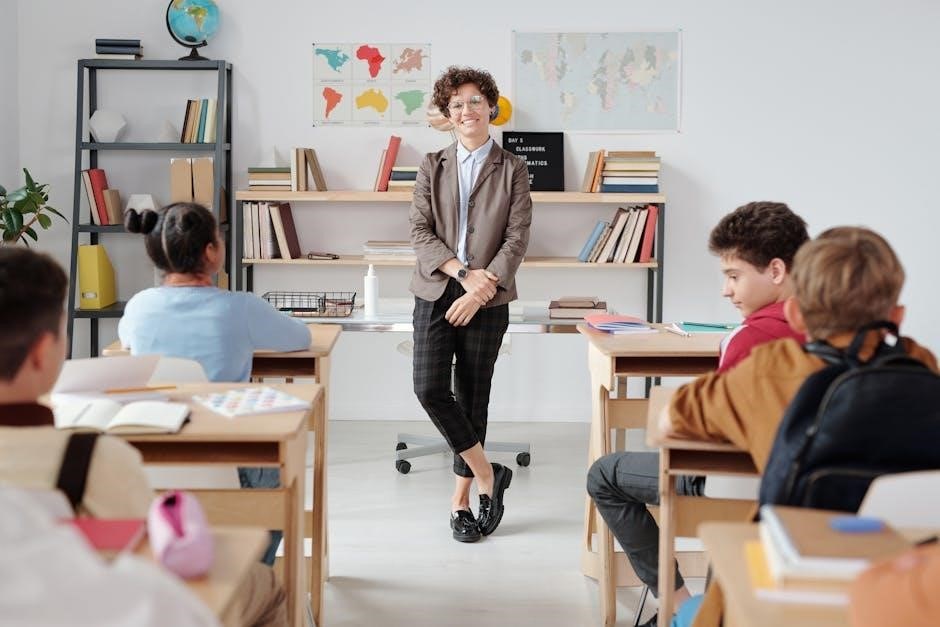Effective teaching strategies for special needs students involve creating inclusive classrooms with skilled teachers using various methods and techniques to support student learning and development every day successfully online․
Overview of Special Needs Education
Special needs education provides support to students with diverse needs, ensuring they receive a quality education․ This includes students with mental disabilities, English language learners, and those with physical disabilities․ The goal of special needs education is to create an inclusive learning environment that caters to the unique requirements of each student․ Teachers play a crucial role in implementing teaching strategies that promote learning and development․ They work collaboratively with specialists and general education teachers to design and implement individualized education plans․ The internet offers a wealth of resources, including pdf documents, that provide guidance on teaching strategies for special needs students․ These resources can help teachers develop effective lesson plans, assess student progress, and create a supportive learning environment․ By understanding the principles of special needs education, teachers can make a positive impact on the lives of their students and help them achieve their full potential․

Understanding the Needs of Special Population Students
Teachers must consider diverse student needs and abilities when planning lessons and activities every day with skilled educators online successfully using various methods․
Accommodating Students with Mental Disabilities and English Language Learners
Accommodating students with mental disabilities and English language learners requires a tailored approach to meet their unique needs and promote inclusive learning environments․
Teachers can use various strategies such as visual aids, simplified language, and repetition to support English language learners․
Additionally, providing extra time to complete assignments and offering one-on-one support can help students with mental disabilities to better understand and retain information, ultimately leading to improved academic outcomes and increased confidence․
By acknowledging and addressing the diverse needs of these students, educators can create a more supportive and inclusive classroom environment that fosters social, emotional, and academic growth for all students․
Effective accommodations can also involve collaborating with specialists, such as speech therapists or counselors, to develop personalized learning plans that cater to the specific requirements of each student․

Creating an Inclusive Classroom Environment
Skilled teachers create inclusive classrooms with diverse methods and techniques to support student learning and development every day successfully online always․
Least Constrained Environment for Optimal Learning
The least constrained environment is usually the most beneficial for students to learn and develop their skills․ This type of environment allows students to feel comfortable and supported, which is essential for their academic success․ Teachers play a crucial role in creating such an environment, and they must be familiar with various inclusion tactics to support students with special needs․ By providing a least constrained environment, teachers can help students with special needs to learn and develop their skills to their full potential․ This environment also helps to promote social interaction and communication among students, which is essential for their emotional and psychological development․ Overall, the least constrained environment is a key factor in creating an inclusive classroom where all students can thrive and reach their full potential․ Effective teaching strategies are essential to achieve this goal․

Teaching Strategies for Special Needs Students
Skilled teachers use various methods and techniques to support student learning and development effectively online every day with different approaches and materials for special needs students always․
Repetition and Focus on Basics for Special Needs Students
Special needs students require repetition and focus on basics to understand and retain information effectively․ Teachers should use various methods to reinforce learning, such as repeating instructions, using visual aids, and providing hands-on activities․ This approach helps students with mental disabilities and English language learners to grasp fundamental concepts and build a strong foundation for future learning․ By focusing on basics and repeating key concepts, teachers can help special needs students develop a deeper understanding of the subject matter and improve their overall academic performance․ Effective teaching strategies, including repetition and focus on basics, can make a significant difference in the educational outcomes of special needs students, enabling them to reach their full potential and succeed in their academic pursuits․ Teachers should be aware of the importance of repetition and focus on basics in teaching special needs students․

Collaborative Planning and Implementation
Teachers work together with specialists to plan and implement effective strategies for special needs students every day online using various methods and techniques successfully․
Coordinating with Specialists and General Education Teachers
Coordinating with specialists and general education teachers is crucial for special needs students․ Teachers must work together to plan and implement effective strategies․ This involves sharing information and resources to support student learning․ By coordinating with specialists, teachers can gain valuable insights and expertise to inform their instruction․ General education teachers can also provide important feedback and suggestions to specialists․ This collaborative approach helps to ensure that special needs students receive comprehensive support․ Effective coordination requires regular communication and meetings between teachers and specialists; This can involve progress monitoring, goal setting, and adjusting instruction to meet student needs․ By working together, teachers and specialists can help special needs students achieve their full potential and succeed in the classroom․ This collaborative approach is essential for providing high-quality education and support to special needs students․ It requires a commitment to teamwork and communication․
Assessment and Evaluation of Special Needs Students
Teachers use various assessment methods to evaluate special needs students’ progress and adjust instruction accordingly every day online successfully with general education teachers and specialists․
Providing Multiple Attempts on Assessments for Special Needs Students
Providing multiple attempts on assessments is a strategy used to support special needs students, allowing them to demonstrate their knowledge and skills in a less stressful environment․ This approach acknowledges that special needs students may require more time and flexibility to complete assessments․ By offering multiple attempts, teachers can help reduce anxiety and increase student confidence, ultimately leading to more accurate assessments of their abilities․ This strategy is particularly useful for students with learning disabilities, who may need to use assistive technology or other accommodations to complete assessments․ Teachers can use various methods to provide multiple attempts, such as offering retakes or using technology to administer assessments in a more flexible and accessible way․ Overall, providing multiple attempts on assessments is an effective way to support special needs students and help them achieve their full potential․ Teachers should consider this strategy when developing assessment plans for their students․